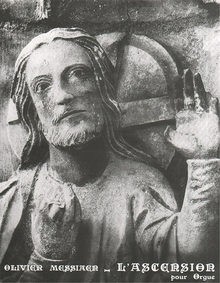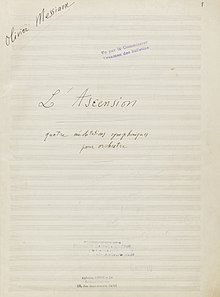|
L'Ascension
L'Ascension (French pronunciation: [lasɑ̃sjɔ̃], lit. 'The Ascension'; official translation: "Ascension Day") is a suite of four symphonic meditations for orchestra that, with the exception of its third movement, were later arranged for pipe organ in 1933–1934. The work was written by the French composer Olivier Messiaen from 1932 to 1933 in Paris, Neuchâtel, and Monaco. It was premièred under the direction of Robert Siohan at the Salle Rameau in Paris on 9 February 1935. It is one of his first major works (the first such for orchestra); and, in both of its iterations, among his most well-known. The work is in four movements and uses modes of limited transposition and complex rhythms, which are characteristic of Messiaen's compositional style. Nevertheless, the work is rooted in tonality and uses key signatures. It is as follows:
For the organ version, in response to the fast scherzic textures of the orchestral third movement which were apparently unsuitable for the instrument, the composer gave up arranging it, replacing it with an entirely new toccata in F-sharp major titled Transports de joie d'une âme devant la gloire du Christ qui est la sienne ("Outbursts of Joy From a Soul Before the Self-Fulfilling Glory of Christ"). A complete performance takes around thirty minutes. The second movement's main theme was originally the theme of a piece for violin and piano called Fantaisie, which was posthumously published. Both editions were published by Éditions Alphonse Leduc. HistoryDevelopment The work's earliest sketches (in short-score format) are described as dating from May of 1932 and were written in the composer's residence, 13 villa Danube in Paris. He completed the work in Neuchâtel during July of that year and began orchestrating it in July of the following year in Monaco. At the time of writing, Messiaen had been teaching at the Schola Cantorum de Paris and had already published a handful of pieces, however, he was mostly known as an organist. He was appointed as titular organist of La Sainte-Trinité following the death of Charles Quef in 1931 and was a former pupil of Marcel Dupré, Charles-Marie Widor, and Paul Dukas. Messiaen had previously written two un-commissioned symphonic meditations and was also working on his third, Hymne au Saint Sacrement. ControversiesAccording to rumour, due to a dispute between Messiaen and the Alphonse Leduc company, Messiaen offered to arrange the work for organ mostly to appease them and to expand profits from the highly-demanding global organ scene. It was published in 1934, with the actual orchestral version following in 1948 (previously, only a copyist's hire-score was available). The organ version continues to be more popular than the orchestral original. InstrumentationThe work is scored for the following instruments:[1]
Form I. Majesté du Christ demandant sa gloire à son Père
The movement is an opening chorale in E major which is scored for the winds and brass sections alone. II. Alléluias sereins d’une âme qui désire le cielIII. Alléluia sur la trompette, alléluia sur la cymbaleIIIa. Transports de joie d'une âme devant la gloire du Christ qui est la sienne (for organ)IV. Prière du Christ montant vers son PèreOrgan version In 1933–34, Messiaen made a version for solo organ. The first, second and fourth movements are arrangements of the orchestral pieces, but Messiaen composed a new third movement, Transports de joie d'une âme devant la gloire du Christ qui est la sienne ("Outbursts of joy from a soul before the glory of Christ which is its own glory"), usually just known as Transports de joie. (ⓘ). The first performance of the organ version was given by the composer himself on January 29, 1935, at the church of Saint-Antoine-des-Quinze-Vingts in Paris.[2] References
External links
|
||||||||||||||||||||||||||||
Portal di Ensiklopedia Dunia
